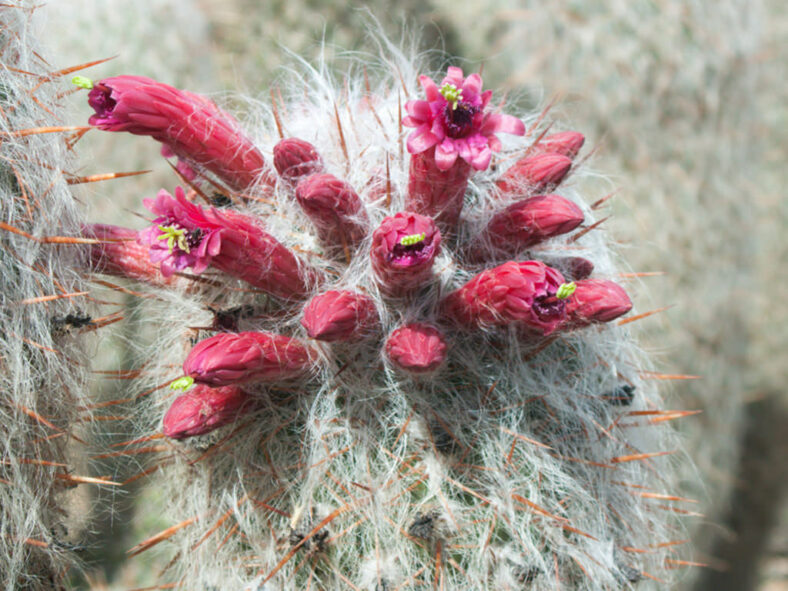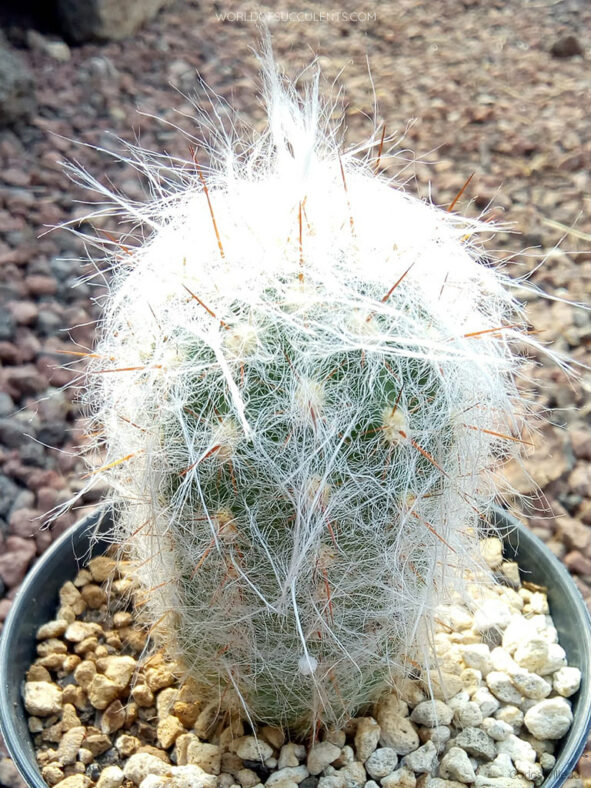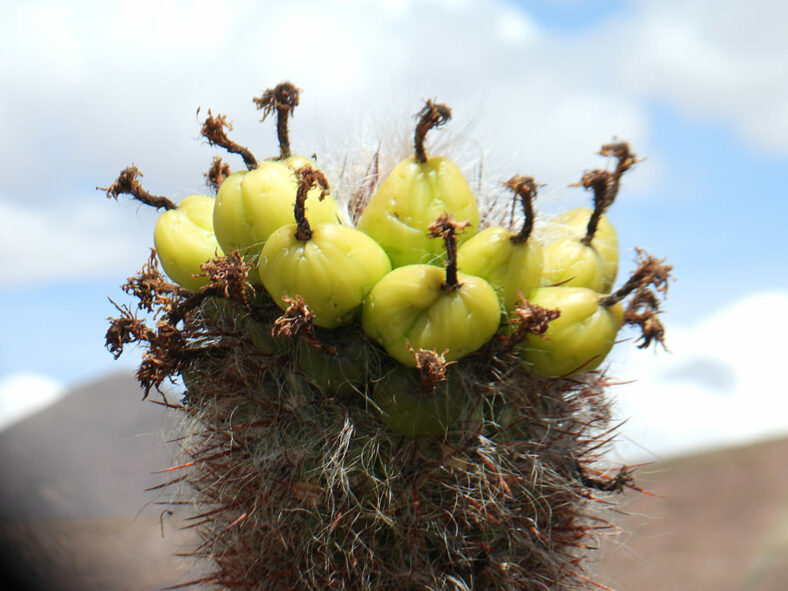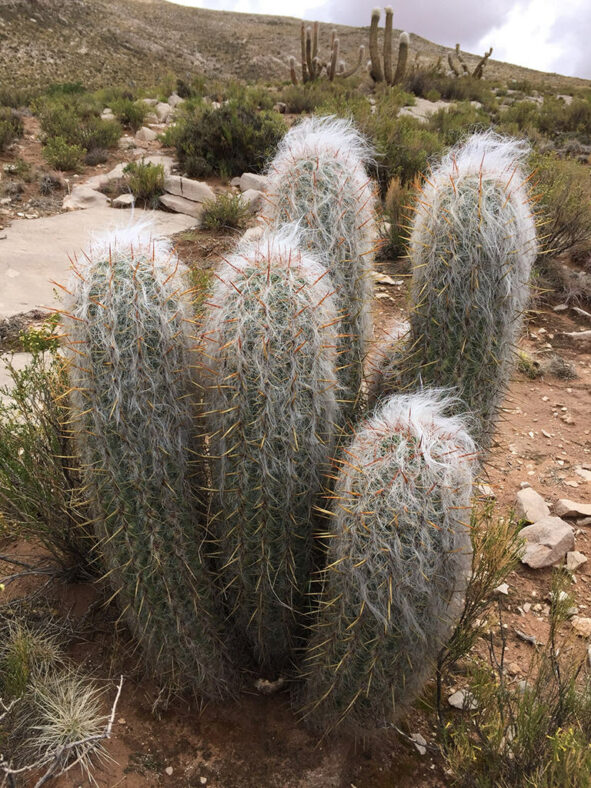Oreocereus celsianus is a cactus with tall, white-haired stems that stand on the highlands of the Andes in South America, like snowy sentinels overlooking valleys. The long white hairs protect the stems from the intense ultraviolet light of higher altitudes.
Scientific Name
Oreocereus celsianus (Lem. ex Salm-Dyck) Riccob.
Common Name(s)
Old Man of the Andes, Old Man of the Mountain
Synonym(s)
Borzicactus celsianus, Cereus celsianus, Cleistocactus celsianus, Echinopsis celsiana, Pilocereus celsianus
Scientific Classification
Family: Cactaceae
Subfamily: Cactoideae
Tribe: Trichocereeae
Genus: Oreocereus
Etymology
The specific epithet "celsianus (pronounced sels-ee-AY-nus) honors Jacques Philippe Martin Cels (1740-1806), a French botanist specializing in horticulture.
Origin
Oreocereus celsianus is native to Argentina, Bolivia, and Peru. It grows in the semi-arid Andean region at elevations that range from 9,510 to 11,810 feet (2,900 to 3,600 m).
Description
Oreocereus celsianus is a slow-growing cactus with columnar, green-grey to dark green stems densely covered with long, white hairs and brown spines. As the plant ages, it branches from the base, forming a clump. The stems are initially prostrate, then erect, and can grow up to 10 feet (3 m) long and 4.8 inches (12 cm) in diameter. They have 9 to 15 tuberous ribs lined with oval, white-felted areoles bearing a cluster of 8 to 13 spines. Each areole bears 1 to 4 central spines measuring up to 3.2 inches (8 cm) long and 7 to 9 radial spines measuring up to 0.8 inches (2 cm) long. The density of the white hairs is greatest at the tip of the stem and gradually decreases toward the base.
In the spring, Oreocereus celsianus produces tubular flowers near the tips of the stems, which open during the day. The flowers are slightly curved and can reach a length of 3.6 inches (9 cm) and a diameter of 1.2 inches (3 cm). They have greenish-brown outer tepals, mauve-pink to dark red inner tepals, and red filaments. The floral tube is covered with short scales and long white and black hairs. The yellow spherical fruits contain several black seeds and split at the base when fully ripe. They can grow up to 2 inches (5 cm) in diameter.

How to Grow and Care for Oreocereus celsianus
Light: Although it can handle partial shade, Oreocereus celsianus thrives in full sun. If grown indoors, a sunny window is a good spot. To encourage balanced growth, rotate the pot a quarter turn every week or two. It is best to move it outdoors from spring to fall if possible.
Soil: This cactus grows best in well-draining soil. You can either use commercial soil for cacti or make your own mix.
Hardiness: During the growing season, Oreocereus celsianus enjoys warm temperatures, while in winter, it prefers cooler temperatures. It grows best in USDA Plant Hardiness Zones 8a to 10b, with average minimum winter temperatures ranging from 10 to 40 °F (-12.2 to 4.4 °C).
Watering: To keep this cactus healthy, water it thoroughly, but allow the soil to dry out completely before watering again. As fall approaches, gradually reduce the watering frequency. During the winter, when it is dormant, water this cactus only enough to prevent shrinking.
Fertilizing: During its growing season, this cactus requires regular fertilizing. A balanced, water-soluble fertilizer diluted to 1/4 strength can be added to each watering. A 10-10-10 fertilizer is ideal. You can also use dry fertilizers instead of making a solution of water and fertilizer. However, stop fertilizing during the winter.
Repotting: You should repot Oreocereus celsianus once a year when it is young and when it outgrows its pot when mature.
Propagation: The easiest method to propagate this cactus is by stem cuttings, as seed propagation is a slow process. Spring and summer are the best times to take cuttings and sow the seeds.
Learn more at How to Grow and Care for Cereus.
Toxicity of Oreocereus celsianus
Oreocereus celsianus is considered non-toxic. However, keep it away from pets and children as it has sharp spines.
Links
- Back to genus Oreocereus
- Succupedia: Browse succulents by Scientific Name, Common Name, Genus, Family, USDA Hardiness Zone, Origin, or cacti by Genus
Photo Gallery


